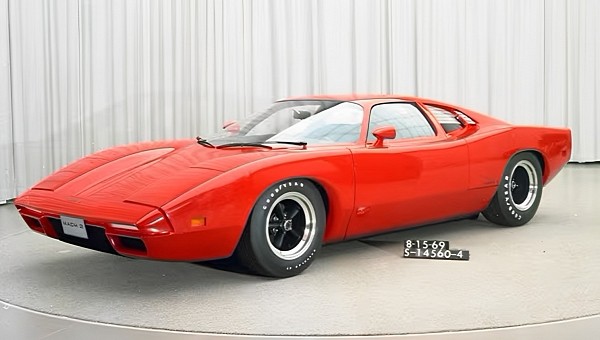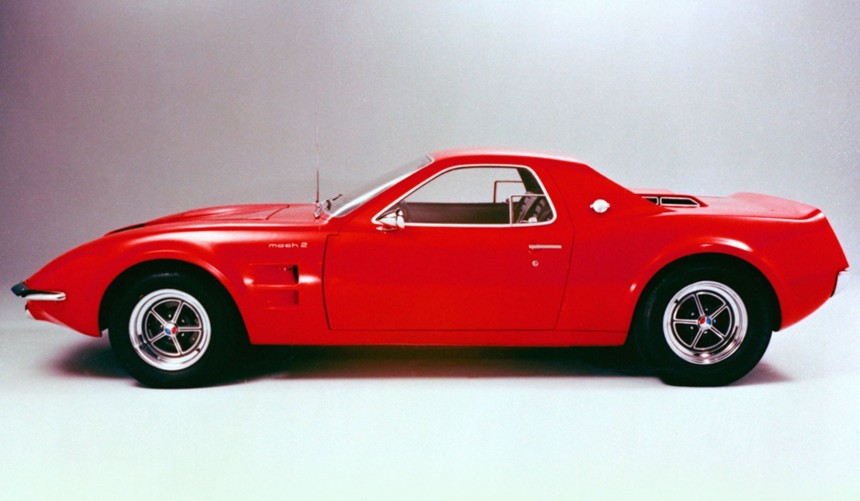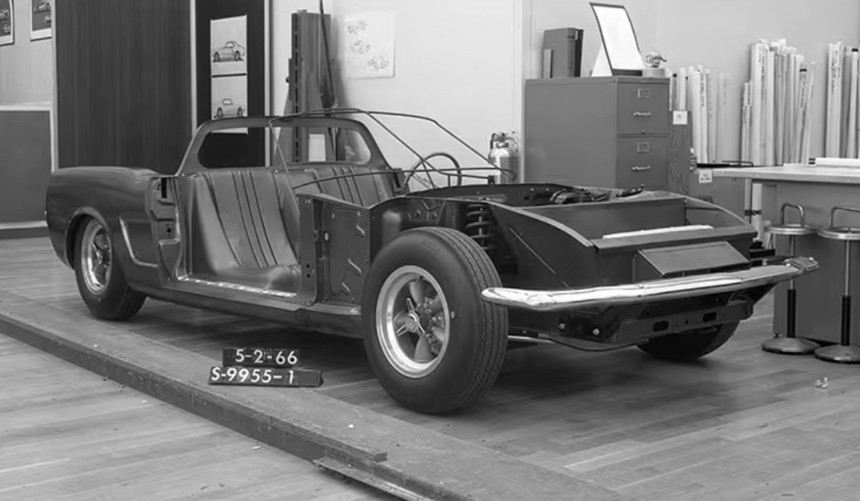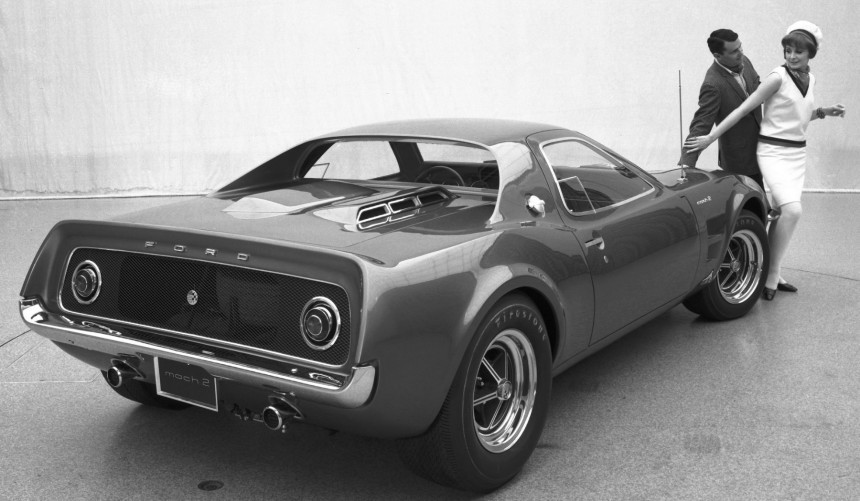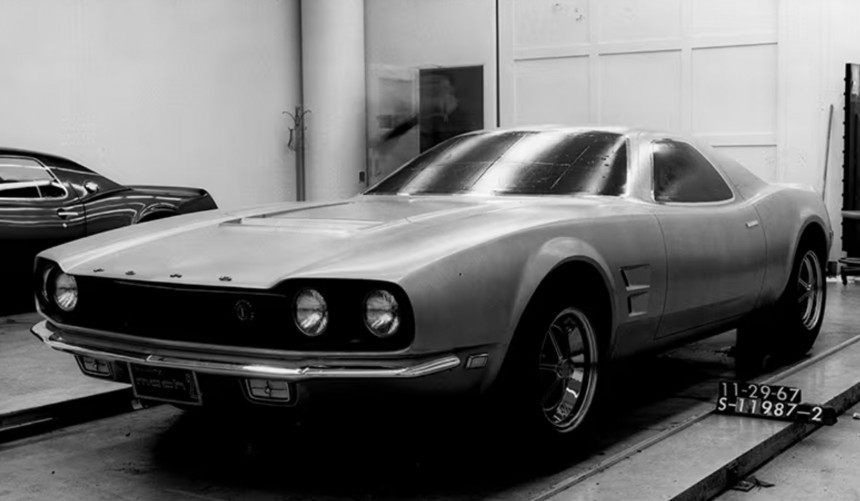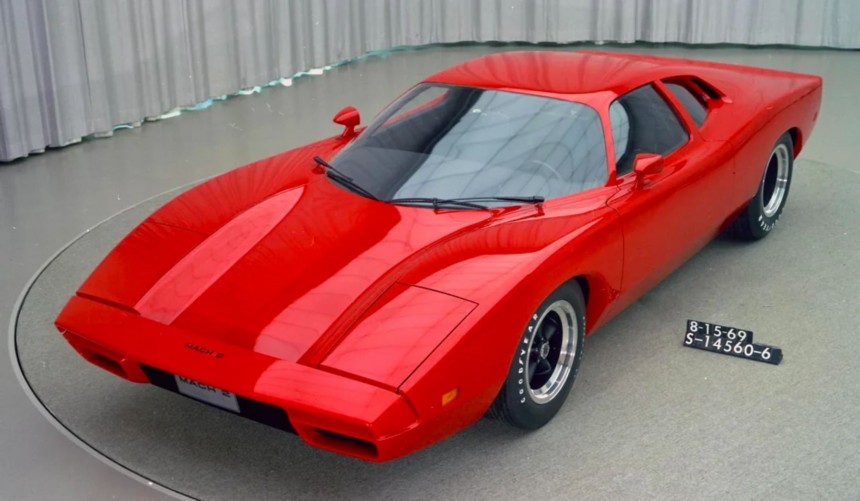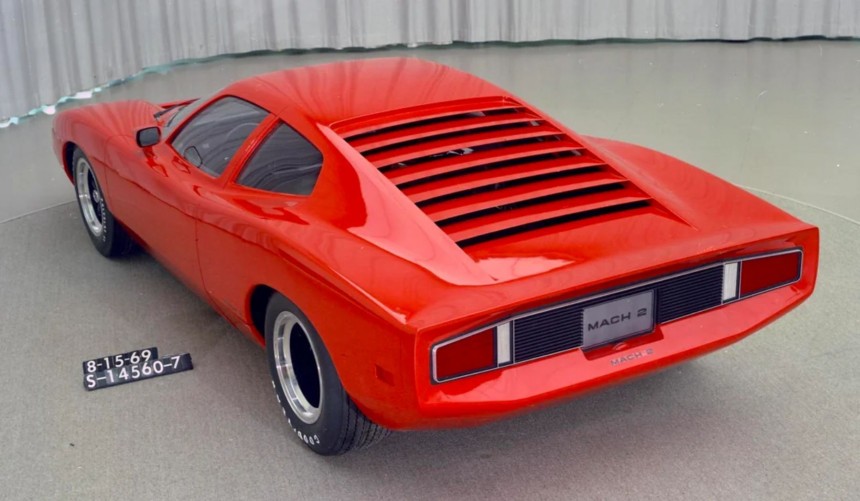A project that started nearly six decades ago and gave birth to a series of fascinating mid-engine sports cars, the Mach 2 remains one of the biggest “what-ifs” in American automotive history.
Officially unveiled to the public on April 17, 1964, at the New York World's Fair, the Mustang was an instant hit that gave birth to the exciting pony car segment and became an automotive icon.
Although six generations were produced since its debut (with a seventh scheduled to come in 2024), the first continues to be the most popular even today, in an era when we have obscenely powerful ‘Stangs like the 1,300-hp GT500 Code Red prowling the streets.
The first generation, which spanned from the second half of 1964 to 1973, was the most diverse in terms of overall improvements and available options, but it was also the most diverse when it came to concept cars. From the mid-engine roadster that engraved the nameplate into the minds of the public years before the production version was revealed, to the Shorty two-seater, the Bertone-designed 2+2, or the spectacular Milano, the first-gen delivered more fascinating concepts than any other Mustang generation.
Possibly the most intriguing, yet long-forgotten series of concepts based on a first-gen chassis was the Mach 2 which completely abandoned the successful front engine/RWD recipe and targeted the sports car segment with a GT40-inspired, mid-engine design.
It all starts in the spring of 1966, about two years after the Mustang’s official debut. Emboldened by the model’s success, Ford decided to continue exploring the platform’s potential beyond the pony car segment.
Thus, the corporation’s Advanced Concepts Department was tasked to begin a program that would research the feasibility of a somewhat-affordable, two-seat sports car that borrowed existing tech as well as the design cues from the widely-popular Mustang.
The goal was to create a product that would convince sports car enthusiasts to refrain from buying a Chevrolet Corvette and choose a similarly-priced Ford instead. To do that, the design and engineering team were instructed to develop a road car that would not only look and perform better. But it should also have the potential to be converted into a race car that would abide by FIA Group 3 and SCCA A-Production regulations.
After several months of intense work, the Advanced Concepts Department created a mid-engine, two-seat chassis mockup as well as a full-size clay model based on sketches done by Eugene Bordinat. Both were presented to the company’s decision-makers who determined them extremely promising and greenlighted the continuation of the program.
Next, Ford’s skunkworks partner Kar-Kraft was contracted to develop a functional chassis that would prove the feasibility of the mid-engine design.
Built around a 1966 Mustang convertible chassis chosen for its extra reinforcements, the feasibility car featured an independent rear suspension designed by Ford’s engineering wizard Klaus Arning and a 289-ci (4.7 liters) V8 mated to a Colotti four-speed transaxle.
Although designers completed a full-size fiberglass body shell for the project, this was never fitted to the feasibility car which was basically a rolling chassis with stock rear fenders from the Mustang and a few modified panels that defined the shape of the future prototypes.
Focus soon shifted to the revised 1967 Mustang platform and Kar-Kraft began building two fully functional prototypes.
The first which would eventually be painted red was the production car candidate. Compared to the feasibility car, its chassis received several modifications including a revised engine cradle, a ZF transaxle deemed superior to the Colotti unit, a set of adjustable Koni shocks, and a redesigned front end meant to make room for a small storage compartment. This prototype received a full fiberglass body that resembled the Corvette from the front and combined elements from the GT40 and the Mustang towards the rear.
The second prototype finished in white was a full-blown race car test mule. It received a modified 289, competition-spec components, and a lighter fiberglass body.
Both were extensively tested in the coming months, but the results were far from encouraging. Though the Mach 2 road car reportedly handled well, it generated too much body roll at high speeds, resulting in severe understeer. To make matters worse, the race car’s chassis was not stiff enough, distorting under heavy loads.
The shortcomings of the first two cars were eventually resolved and by late-1967, plans for an improved version codenamed Mach 2B were sent to management as a full production proposal.
Records show that Ford seriously considered commencing production of the Mach 2 starting with the 1969 model year, contracting A.O. Smith Corporation in Ionia, Michigan to assemble the car and manufacture its fiberglass body. These plans were scrapped, but the car came close to production again, this time starting with the 1971 model year.
No longer based on the Mustang chassis but designed to use the upcoming 1970 Maverick’s Delta platform. The Mach 2B received a redesigned body that featured a totally new front end with dual headlights instead of the hideaway units of the 2A. To make it even more exciting, Ford wanted to equip it with the mighty Boss 429 big-block V8 and planned to add an automatic transmission to the options list.
Unfortunately, the Mach 2B proposals never made it into production. It’s unclear whether a fully-functional prototype was built but sources state that three distinct, full-size clay models were constructed.
The project continued and in August 1969, another thoroughly revised car was presented to the Blue Oval’s top brass.
Codenamed Mach 2C, not much is known about this one except that a full-size, highly-detailed static prototype was built. It was designed by Larry Shinoda, the former GM stylist who played a major role in the development of legendary Chevrolet concepts like the Mako Shark Corvettes and the first two CERV race cars.
As you can see in the pictures, it looked way ahead of its time, resembling European supercars built during the 1970s and 1980s. If it made it into production, the Mach 2C had the potential to become one of the most iconic sports cars ever built, especially if it would have been powered by the Boss 429 or something older, yet more exotic, like the SOHC 427 “Cammer”.
Although it’s recognized as a Mustang concept because it was initially built around the pony car’s chassis, the Mach 2 was never meant to carry the iconic nameplate.
It’s unclear whether Ford planned to use the Mach 2 moniker for the production version or come up with something new, but the mid-engine sports car was meant to have its own character.
The initial plan was to build between 500 and 1,500 per year, with a sticker price that didn’t exceed $7,500 (around $66,000 today). Moreover, to rival the Corvette, Ford wanted to offer an optional roadster version alongside the standard coupe.
Although it was developed nearly six decades ago, this amazing series of Ford concept cars is still fascinating today, and we can’t help but wonder how it would have impacted the American automotive industry if it made it into production.
Although six generations were produced since its debut (with a seventh scheduled to come in 2024), the first continues to be the most popular even today, in an era when we have obscenely powerful ‘Stangs like the 1,300-hp GT500 Code Red prowling the streets.
The first generation, which spanned from the second half of 1964 to 1973, was the most diverse in terms of overall improvements and available options, but it was also the most diverse when it came to concept cars. From the mid-engine roadster that engraved the nameplate into the minds of the public years before the production version was revealed, to the Shorty two-seater, the Bertone-designed 2+2, or the spectacular Milano, the first-gen delivered more fascinating concepts than any other Mustang generation.
Possibly the most intriguing, yet long-forgotten series of concepts based on a first-gen chassis was the Mach 2 which completely abandoned the successful front engine/RWD recipe and targeted the sports car segment with a GT40-inspired, mid-engine design.
The origins of the Mach 2 program
Thus, the corporation’s Advanced Concepts Department was tasked to begin a program that would research the feasibility of a somewhat-affordable, two-seat sports car that borrowed existing tech as well as the design cues from the widely-popular Mustang.
The goal was to create a product that would convince sports car enthusiasts to refrain from buying a Chevrolet Corvette and choose a similarly-priced Ford instead. To do that, the design and engineering team were instructed to develop a road car that would not only look and perform better. But it should also have the potential to be converted into a race car that would abide by FIA Group 3 and SCCA A-Production regulations.
The first chassis
Next, Ford’s skunkworks partner Kar-Kraft was contracted to develop a functional chassis that would prove the feasibility of the mid-engine design.
Built around a 1966 Mustang convertible chassis chosen for its extra reinforcements, the feasibility car featured an independent rear suspension designed by Ford’s engineering wizard Klaus Arning and a 289-ci (4.7 liters) V8 mated to a Colotti four-speed transaxle.
Although designers completed a full-size fiberglass body shell for the project, this was never fitted to the feasibility car which was basically a rolling chassis with stock rear fenders from the Mustang and a few modified panels that defined the shape of the future prototypes.
Mach 2A: the first two functional prototypes
The first which would eventually be painted red was the production car candidate. Compared to the feasibility car, its chassis received several modifications including a revised engine cradle, a ZF transaxle deemed superior to the Colotti unit, a set of adjustable Koni shocks, and a redesigned front end meant to make room for a small storage compartment. This prototype received a full fiberglass body that resembled the Corvette from the front and combined elements from the GT40 and the Mustang towards the rear.
The second prototype finished in white was a full-blown race car test mule. It received a modified 289, competition-spec components, and a lighter fiberglass body.
Both were extensively tested in the coming months, but the results were far from encouraging. Though the Mach 2 road car reportedly handled well, it generated too much body roll at high speeds, resulting in severe understeer. To make matters worse, the race car’s chassis was not stiff enough, distorting under heavy loads.
Mach 2B: the design proposal that almost made it into production
Records show that Ford seriously considered commencing production of the Mach 2 starting with the 1969 model year, contracting A.O. Smith Corporation in Ionia, Michigan to assemble the car and manufacture its fiberglass body. These plans were scrapped, but the car came close to production again, this time starting with the 1971 model year.
No longer based on the Mustang chassis but designed to use the upcoming 1970 Maverick’s Delta platform. The Mach 2B received a redesigned body that featured a totally new front end with dual headlights instead of the hideaway units of the 2A. To make it even more exciting, Ford wanted to equip it with the mighty Boss 429 big-block V8 and planned to add an automatic transmission to the options list.
Unfortunately, the Mach 2B proposals never made it into production. It’s unclear whether a fully-functional prototype was built but sources state that three distinct, full-size clay models were constructed.
Mach 2C: Larry Shinoda’s supercar-looking concept
Codenamed Mach 2C, not much is known about this one except that a full-size, highly-detailed static prototype was built. It was designed by Larry Shinoda, the former GM stylist who played a major role in the development of legendary Chevrolet concepts like the Mako Shark Corvettes and the first two CERV race cars.
As you can see in the pictures, it looked way ahead of its time, resembling European supercars built during the 1970s and 1980s. If it made it into production, the Mach 2C had the potential to become one of the most iconic sports cars ever built, especially if it would have been powered by the Boss 429 or something older, yet more exotic, like the SOHC 427 “Cammer”.
It was not meant to be a mid-engine Mustang
It’s unclear whether Ford planned to use the Mach 2 moniker for the production version or come up with something new, but the mid-engine sports car was meant to have its own character.
The initial plan was to build between 500 and 1,500 per year, with a sticker price that didn’t exceed $7,500 (around $66,000 today). Moreover, to rival the Corvette, Ford wanted to offer an optional roadster version alongside the standard coupe.
Although it was developed nearly six decades ago, this amazing series of Ford concept cars is still fascinating today, and we can’t help but wonder how it would have impacted the American automotive industry if it made it into production.
